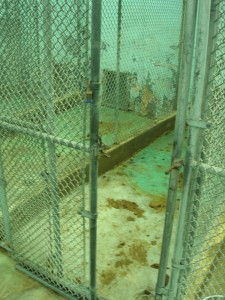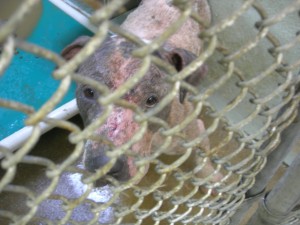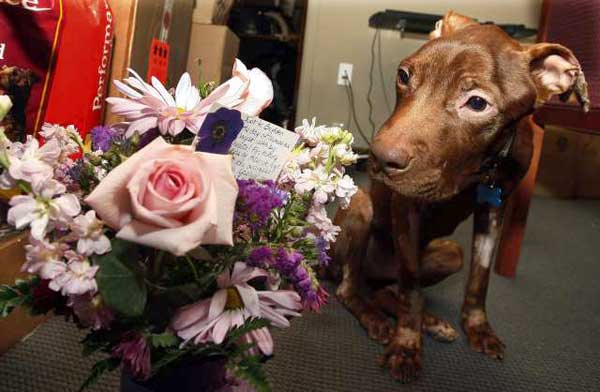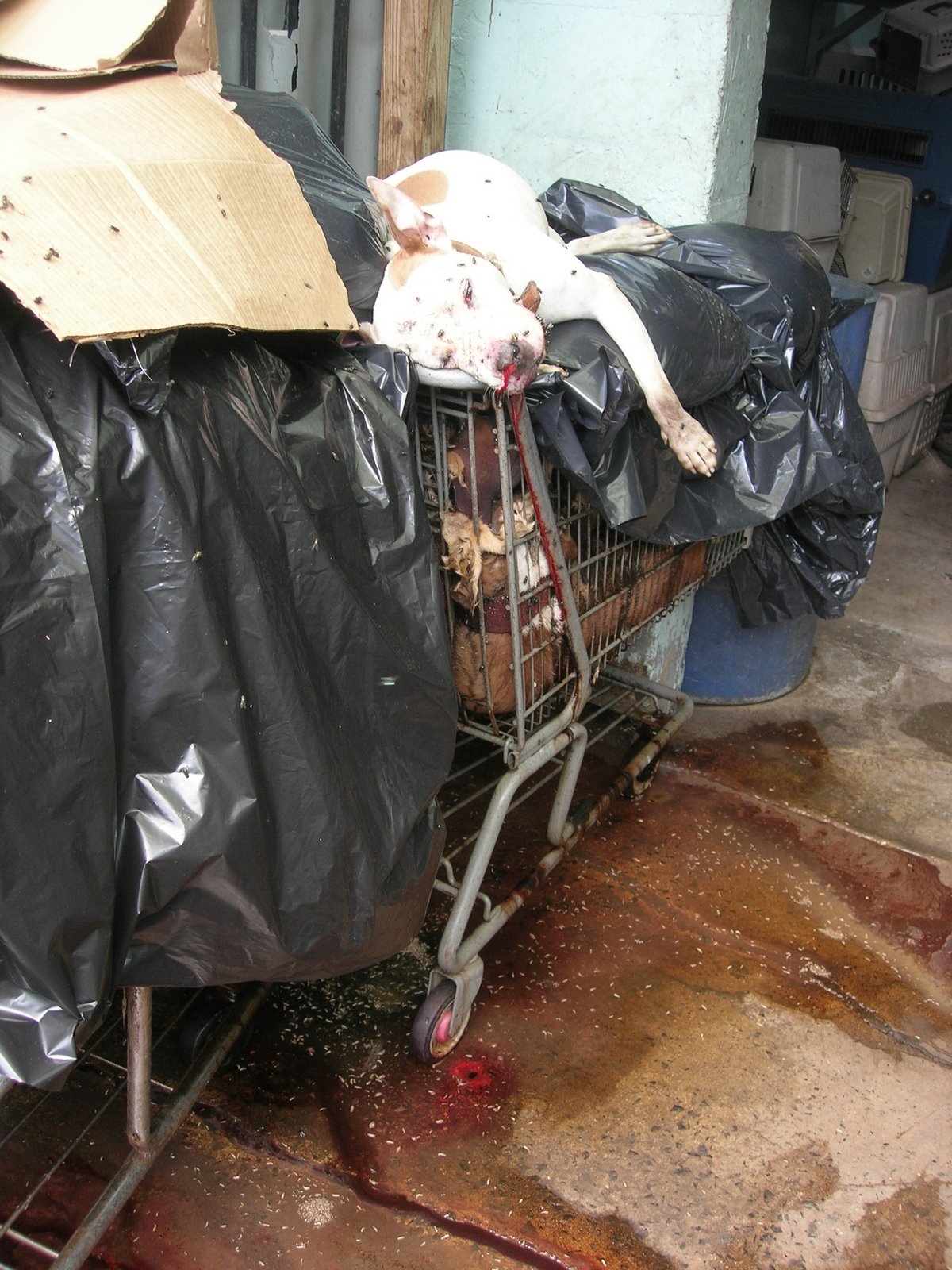
“[T]rademark registration number 23699” is a “very valuable brand for commercial exploitation and fundraising.” —Associated Humane Societies of New Jersey, describing Patrick in their lawsuit against the City of Newark and the veterinarians who saved his life.
To caring and compassionate people everywhere, he is known as “Patrick,” the horrifically abused dog who was discarded and left for dead in Newark, New Jersey. But to the Associated Humane Societies of New Jersey, the anti-No Kill organization with a history of neglect, abuse, and corruption that is seeking custody of Patrick, he is “trademark registration number 23699” which they describe as a “very valuable brand for commercial exploitation and fundraising.” And they are suing both the City of Newark and the veterinarian that saved Patrick’s life to protect it.
In its recently filed civil lawsuit, AHS claims the City of Newark and Garden State Veterinary Specialists (GSVS) conspired to deprive AHS of its property rights in Patrick and thus cost them vast fundraising potential when the City argued that Patrick should stay with the veterinarians who were treating him pending resolution of the criminal case against his former abuser. Instead of seeing the City and GSVS’s desire to give Patrick the life and love he deserves by having him stay with the veterinarians who saved him until he fully recovers and then being adopted by the nurse with whom he has bonded, AHS can only see dollar signs, a conspiracy to “deprive AHS of its property interest in Patrick.” And they want to get paid. They’ve asked the superior court of Essex County, New Jersey to award them money damages because apparently, the $9,000,000 in annual revenues apparently isn’t enough.
According to AHS, saving Patrick’s life, raising money to pay for his care, trying to keep him in perhaps the only loving environment he has ever known, and trying to give him a loving home away from further exploitation is not the right thing to do because, regardless of what might be in the best interests of Patrick, it amounts to “interference with [AHS] business activities” and its “economic advantage” resulting in “significant losses.” They’ve not only asked for all the money they could have potentially raised off of him, they’ve even asked the court to award them the money people donated directly to the veterinarian which went to pay for Patrick’s medical care, with interest.
For those who are familiar with AHS sordid history, the latest move may be shocking, but it is not surprising. AHS has a long history of corruption, neglect, inhumane treatment, and a refusal to put the best interests of animals above its own. In 2003, the State Commission of Investigation,
[R]eleased the results of a wide-ranging investigation into waste and abuse by one of New Jersey’s leading nonprofit animal-shelter organizations, Associated Humane Societies (AHS). The Commission found that AHS officials over the years have engaged in questionable financial practices, conflicts of interest, mismanagement and negligent animal care to the extent that the organization effectively lost sight of its core mission. Despite huge and highly successful fund-raising campaigns, the Commission found, “the history of AHS’s shelter operation has been dominated by deplorable kennel conditions, inhumane treatment of animals by workers, mismanagement and nonexistent or inadequate medical care.”
The Commission’s findings, going back to the 1980s, included: “Accountability so lax that millions of dollars accumulated in AHS cash and investment accounts while the care and feeding of sick and injured animals went begging” and “Deplorable shelter conditions and inadequate or absent veterinary care for shelter animals.”
 Despite the 2003 findings, state animal welfare inspectors found even more deplorable conditions for animals in 2009, including “severe fly and maggot infestation,” “overwhelming malodorous smell,” “large amount of blood was found splattered on the floor, walls, and viewing window,” sick and injured animals “not being treated.” Animals “exhibiting signs of severe bloody, watery diarrhea and lethargy : not separated or receiving treatment.” Of the 4,296 cats taken in, 2,721 were put to death. Another 616 either died or are missing. Of the 3,423 dogs taken in, 806 were killed. Another 60 either died or are missing.
Despite the 2003 findings, state animal welfare inspectors found even more deplorable conditions for animals in 2009, including “severe fly and maggot infestation,” “overwhelming malodorous smell,” “large amount of blood was found splattered on the floor, walls, and viewing window,” sick and injured animals “not being treated.” Animals “exhibiting signs of severe bloody, watery diarrhea and lethargy : not separated or receiving treatment.” Of the 4,296 cats taken in, 2,721 were put to death. Another 616 either died or are missing. Of the 3,423 dogs taken in, 806 were killed. Another 60 either died or are missing.
And while AHS takes great pains to say that these conditions are all in the past, this year, given the widespread and abusive problems going back to the 1980s as documented in the State Commission of Investigation inspection of 2003 and the 2009 inspection, state investigators should have found a pristine shelter. They did not. Even in 2011, kennel staff were still hosing down the kennel hallway with chemicals and water with the dogs still inside their cages, “further exposing them to contaminates and spray from the hoses.”
Even in 2011, there is evidence that they do not clean or disinfect the automatic feeders because there are layers of caked on food. Even in 2011, “Some animals displaying signs of illness are not being provided with prompt medical care.”
Even in 2011, “[S]ick shelter animals [are] intermixed with owned animals in the public medical room.” In addition, some of those who were in charge in 2003, who were in charge of 2009, and who allowed those conditions to occur, are still in charge in 2011.
Even in 2011, while communities across the country have invested in modern housing facilities, AHS continues to house the animals in dilapidated, even dangerous, conditions. You do not wait for a roof to collapse to replace it. You do not wait for a state inspection report to tell you rotted food in the automatic dispensers is bad to discard it.
 But caring for those animals properly and giving them the resources they need to be housed in modern conditions conducive to their physical and mental well-being as well as to be saved (rather than killed), has not been a priority for AHS because those animals are apparently not worthy of it. They don’t matter because they cost AHS money, requiring it to spend some of the millions they raise every year, even though they raise it by promising to provide for those animals. They are not even worthy of foster homes, even if it means their lives are spared. AHS refuses to allow it.
But caring for those animals properly and giving them the resources they need to be housed in modern conditions conducive to their physical and mental well-being as well as to be saved (rather than killed), has not been a priority for AHS because those animals are apparently not worthy of it. They don’t matter because they cost AHS money, requiring it to spend some of the millions they raise every year, even though they raise it by promising to provide for those animals. They are not even worthy of foster homes, even if it means their lives are spared. AHS refuses to allow it.
The one that matters, however, is Patrick—or, as AHS calls him, “trademark registration number 23699.” Because Patrick has the potential to make AHS money—a lot of money. Patrick is, in the words of AHS in its civil lawsuit, a “very valuable brand for commercial exploitation and fundraising.” And they want the taxpayers of New Jersey and the veterinary clinic that saved Patrick’s life to pay up.
This isn’t the first time AHS has filed a court action to protect their “property” interests in “trademark registration number 23699.” They filed a motion in the underlying criminal case currently pending against his abuser to get custody of Patrick in order to stick him on display in their “Popcorn Zoo,” where they could continue to fundraise off of him. That motion was denied. The court argued that Patrick should stay with the veterinarian and the caregivers he has bonded with pending the resolution of the criminal case. That may have been what was in Patrick’s best interest, but it was not in the best interest of AHS’ pocket book. They subsequently filed an appeal of the court’s ruling. Thankfully, the appeal was also denied. And while well-wishers for Patrick around the country let out a collective sigh of relief, the celebration was premature. There is little doubt that when the criminal case is concluded, AHS will be back demanding full custody of Patrick, whom they see as their “valuable” “property.”
In the meantime, however, they aren’t content to simply wait for the criminal case to conclude so they can seek custody in order to fundraise off of him. They want the money they believe they could have “commercially exploit[ed]” off of Patrick now. And they want lots of it. They’ve asked the court for money damages, consequential damages, interest on any damages, and punitive damages.
Despite a campaign of intimidation, fear-mongering about No Kill, a lawsuit and threats of lawsuits by AHS, the Mayor of Newark fought back once before ordering AHS to take no further action with regards to Patrick. And thankfully, there is no evidence that the Mayor will back down now.

And so while those of us who want what is best for Patrick see him as a dog who deserves what all dogs deserve, a loving home and the care of a loving family, AHS sees him as a “very valuable brand for commercial exploitation and fundraising.” And while those of us who want what is best for Patrick have hoped for the fairy tale ending he deserves, that is incompatible with AHS’ belief he is their “trademark” for “fundraising purposes.” And while those of us who want what is best for Patrick believe he has rights, independent of his relationship to humans, AHS believes he is the “property of AHS.” And while those of us who want what is best for Patrick see him as a beautiful dog who deserves a beautiful life, AHS argues that he is “trademark registration number 23699” which will make them a lot of money.
The question is: Will AHS succeed in destroying Patrick’s happiness to get it?
For further reading:

A photograph from the 2009 state inspection of AHS in Newark: a dead dog, bleeding, whose body and floor is teeming with maggots. To view the rest of the photographs, including state inspection reports in 2003, 2009, and 2011, click here. (Warning: Very graphic.)
